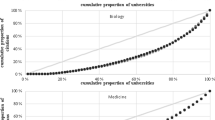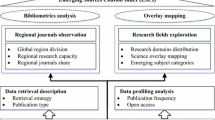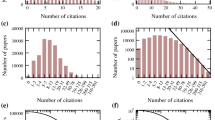Abstract
Amid the enormous volume of knowledge generated due to knowledge explosion, to a great extent, scientific literature mining can play a crucial role in research evaluation and tracking of important developments. Linked through citation relations, scientific literature forms network of papers or citation networks. Citation network analysis is gaining recognition as effective tool for research evaluation. Paradigm shift detection is of great importance to a multitude of beneficiaries and prediction of such paradigm shifts is of much greater gravity towards policy making. Recently, a metric named Flow Vergence (FV) gradient is proposed to detect paradigm shift pivots in scientific literature using the property named as FV effect. In this paper, its predictive power is investigated and tested statically and dynamically using publications in the field Nanotechnology for Engineering for a period 1989–2014. Validation included a post analysis validation of the field in 2017. As predictive power of FV gradient is confirmed, it can be regarded as an effective method for prediction of likely paradigm shifts and added to the tool kit of research evaluators and policy makers.





Similar content being viewed by others
References
Bastian, M., Heymann, S., & Jacomy, M. (2009). Gephi: An open source software for exploring and manipulating networks. ICWSM, 8, 361–362.
Bonacich, P. (1972). Factoring and weighting approaches to status scores and clique identification. Journal of Mathematical Sociology, 2(1), 113–120.
Borgatti, S. P. (2005). Centrality and network flow. Social Networks, 27(1), 55–71.
Bornmann, L., & Marx, W. (2012). The Anna Karenina principle: A way of thinking about success in science. Journal of the American Society for Information Science and Technology, 63(10), 2037–2051.
Chen, C. (2006). CiteSpace II: Detecting and visualizing emerging trends and transient patterns in scientific literature. Journal of American Society of Information Science and Technology, 57(3), 359–377.
de Solla Price, D. J. (1965). Networks of scientific papers. Science, 149(3683), 510–515.
Freeman, L. C. (1977). A set of measures of centrality based on betweenness. Sociometry, 40, 35–41.
Garfield, E. (1955). Citation indexes for science: A new dimension in documentation through association of ideas. Science, 122(3159), 108–111.
Garfield, E. (1957). Breaking the subject index barrier—A citation index for chemical patents. Journal of the Patent Office Society, 39, 583.
Garfield, E. (1964). Science citation index—A new dimension in indexing. Science, 144(3619), 649–654.
Garfield, E., Paris, S., & Stock, W. G. (2006). Histcitetm: A software tool for informetric analysis of citation linkage. Information Wissenschaft und Praxis, 57(8), 391.
Garfield, E., Sher, I. H., & Torpie R. J. (1964). The use of citation data in writing the history of science. Technical report, DTIC Document.
Kuhn, T. S., & Hawkins, D. (1963). The structure of scientific revolutions. American Journal of Physics, 31(7), 554–555.
Lathabai, H. H., Prabhakaran, T., & Changat, M. (2015). Centrality and flow vergence gradient based path analysis of scientific literature: A case study of biotechnology for engineering. Physica A: Statistical Mechanics and its Applications, 429, 157–168.
Lathabai, H. H., Prabhakaran, T., & Changat, M. (2017). Contextual productivity assessment of authors and journals: A network scientometric approach. Scientometrics, 110(2), 711–737.
Marx, W., & Bornmann, L. (2013). The emergence of plate tectonics and the Kuhnian model of paradigm shift: A bibliometric case study based on the Anna Karenina principle. Scientometrics, 94(2), 595–614.
Moya-Anegón, F., Vargas-Quesada, B., Chinchilla-Rodríguez, Z., Corera-Álvarez, E., Munoz-Fernández, F. J., Herrero-Solana, V., et al. (2007). Visualizing the marrow of science. Journal of the American Society for Information Science and Technology, 58(14), 2167–2179.
Newman, M. E. J. (2008). The mathematics of networks. The New Palgrave Encyclopedia of Economics, 2(2008), 1–12.
Prabhakaran, T., Lathabai, H. H., & George, S. (2018). Competing, complementary and co-existing paradigms in scientific literature: A case study of nanotechnology for engineering. Scientometrics (Submitted).
Prabhakaran, T., Lathabai, H. H., & Manoj, C. (2015). Detection of paradigm shifts and emerging fields using scientific network: A case study of information technology for engineering. Technological Forecasting and Social Change, 91, 124–145.
Rafols, I., Porter, A. L., & Leydesdorff, L. (2010). Science overlay maps: A new tool for research policy and library management. Journal of the Association for Information Science and Technology, 61(9), 1871–1887.
Ralph, G. (1967). A computer oriented, graph theoretic analysis of citation index structures. In B. Flood (Ed.), Three Drexel information science research studies (pp. 3–46). Philadelphia: Drexel University Press.
Seidman, S. B. (1983). Network structure and minimum degree. Social Networks, 5(3), 269–287.
Shibata, N., Kajikawa, Y., Takeda, Y., Sakata, I., & Matsushima, K. (2011). Detecting emerging research fronts in regenerative medicine by the citation network analysis of scientific publications. Technological Forecasting and Social Change, 78(2), 274–282.
Waltman, L., van Eck, N. J., & Noyons, E. C. M. (2010). A unified approach to mapping and clustering of bibliometric networks. Journal of Informetrics, 4(4), 629–635.
Wang, D., Song, C., & Barabási, A.-L. (2013). Quantifying long-term scientific impact. Science, 342(6154), 127–132.
Web of Science. Clarivate analytics. https://webofknowledge.com/. Accessed January 27, 2017.
Acknowledgements
This work used facility provided by ‘Scientometric Lab’ (Order No. Pl.A1/Annual plan 16-17/Imp.plan/16 dtd. 29/11/2016), Department of Futures Studies, University of Kerala.
Author information
Authors and Affiliations
Corresponding author
Rights and permissions
About this article
Cite this article
Prabhakaran, T., Lathabai, H.H., George, S. et al. Towards prediction of paradigm shifts from scientific literature. Scientometrics 117, 1611–1644 (2018). https://doi.org/10.1007/s11192-018-2931-3
Received:
Published:
Issue Date:
DOI: https://doi.org/10.1007/s11192-018-2931-3




